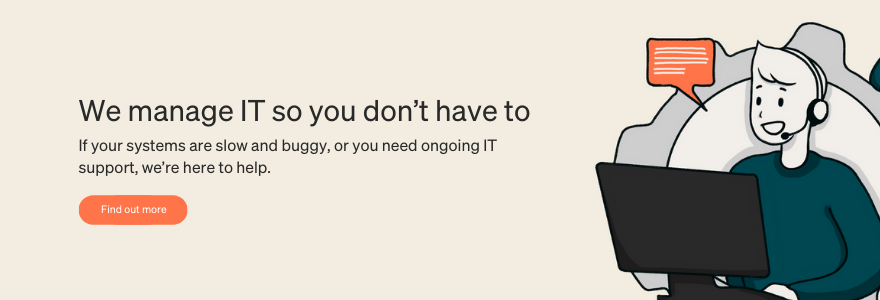For all businesses in Australia, adaptability and efficiency are key goals – and IT outsourcing has emerged as a strategic solution for organisations looking to optimise their operations. Small and medium-sized businesses (SMBs), in particular, have harnessed the power of IT outsourcing to reduce costs, access specialised expertise, and stay competitive. However, the success of an IT outsourcing endeavour hinges on one critical aspect: measuring Return on Investment (ROI).
Why measure ROI in IT outsourcing?
The decision to outsource IT services is a significant one, often requiring substantial financial investment and resource allocation. Measuring ROI in IT outsourcing is indispensable for several compelling reasons:
- It serves as a validation of the initial decision, providing tangible evidence of its advantages.
- It illuminates areas of underperformance that can be addressed to enhance the value gained from outsourcing.
- ROI measurements provide insights to guide future business decisions.

Essential key performance indicators (KPIs) for IT outsourcing
To effectively gauge the ROI of an outsourced IT team, it’s essential to identify and track the right Key Performance Indicators. Here are some fundamental KPIs to consider:
- Cost efficiency: This KPI measures the savings achieved through outsourcing, considering both direct and indirect costs. It offers a clear picture of the financial impact of outsourcing, allowing organisations to assess whether the cost-effectiveness aligns with their goals.
- Quality of work: Assessing the quality of work produced by the outsourced team is vital to determining their contribution to business outcomes. Quality metrics include code quality, the number of bugs, system performance, and adherence to industry standards.
- Timeliness: The ability of the outsourced team to meet project timelines and deadlines can directly impact business operations and customer satisfaction. Timeliness metrics encompass response times, adherence to project timelines, and the speed of task completion.
A step-by-step guide to measuring ROI in IT outsourcing
Effectively measuring ROI requires a systematic approach. A well-structured process ensures that all relevant costs and benefits are considered, allowing for accurate ROI calculation. Here’s a step-by-step guide to measure the ROI of your IT outsourcing initiative:
- Identify key costs and benefits: Begin by listing all the costs associated with outsourcing (e.g., vendor fees, management time) and the benefits received (e.g., reduced staffing costs, increased productivity). This comprehensive list serves as the foundation for your ROI analysis.
- Quantify costs and benefits: Assign monetary values to the identified costs and benefits. While quantifying direct costs may be straightforward, valuing intangible benefits such as improved customer satisfaction or enhanced business agility may require specific methodologies like the Balanced Scorecard or the Value Scorecard approach.
- Calculate ROI: The ROI calculation itself is relatively straightforward: subtract the total costs from the total benefits and then divide this by the total costs. Multiply the result by 100 to obtain the ROI percentage. A positive ROI indicates that the benefits outweigh the costs, validating the outsourcing decision.

ROI should not be viewed as a one-time assessment. Business landscapes evolve, and so do the costs and benefits associated with outsourcing. Regularly monitor ROI to ensure that the outsourcing relationship remains aligned with your organisational goals. This ongoing assessment ensures you can adjust if needed.
Risks of not measuring ROI
Neglecting to measure the ROI of your IT outsourced team can lead to several undesirable outcomes. It’s akin to navigating uncharted waters without a compass, leaving your organisation vulnerable to potential pitfalls:
- Ineffective cost management: Without a clear understanding of the ROI, you may not realise when the cost of outsourcing outweighs its benefits. This lack of financial visibility can lead to financial inefficiencies and wasted resources.
- Overlooked underperformance: A failure to measure ROI can result in underperforming areas going unnoticed and unaddressed. Organisations risk missing opportunities for improvement and efficiency enhancement.
- Missed opportunities for improvement: Regular ROI measurement can reveal opportunities to get the most out of the outsourcing relationship and increase the value you get from it. By neglecting ROI measurement, organisations may overlook chances to enhance their operations and competitiveness.
Best practices for maximising ROI
To maximise ROI from IT outsourcing, consider adopting these best practices:
- Strategic outsourcing: Identify tasks and functions that can be more efficiently completed by an outsourced team. This often includes specialised or repetitive tasks where outsourcing can deliver significant cost savings and expertise.
- Setting clear expectations: Define clear objectives and deliverables for the outsourced team. Transparency and alignment with your business goals are essential for successful outsourcing relationships.
- Open communication: Maintain open and regular communication with your outsourced team. This keeps all parties informed, fosters collaboration, and helps address any issues promptly.
As you can see, measuring the ROI of IT outsourcing is not a one-time event but an ongoing process that demands strategic thinking, the right KPIs, and the effective use of tools and technology. With careful planning and continuous improvement, organisations can maximise the benefits derived from outsourcing and drive their business towards greater efficiency and competitiveness.
Otto IT – Expert, ROI-driven IT outsourcing solutions for small businesses
At Otto IT, we understand the significance of ROI measurement in IT outsourcing. Our ISO27001 certified MSP in Melbourne is committed to helping businesses maximise their ROI by delivering high-quality IT services tailored to your unique needs, from managed IT services and cloud services to cybersecurity, business intelligence, and business continuity solutions. Contact us today to learn how we can be your trusted partner in achieving IT excellence right here in Australia.




